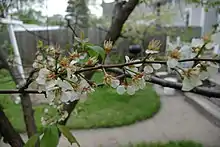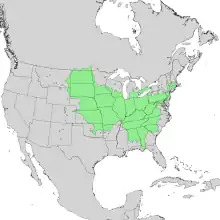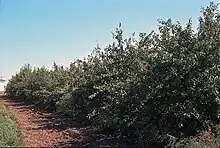| Prunus americana | |
|---|---|
 | |
| Scientific classification | |
| Kingdom: | Plantae |
| Clade: | Tracheophytes |
| Clade: | Angiosperms |
| Clade: | Eudicots |
| Clade: | Rosids |
| Order: | Rosales |
| Family: | Rosaceae |
| Genus: | Prunus |
| Subgenus: | Prunus subg. Prunus |
| Section: | Prunus sect. Prunocerasus |
| Species: | P. americana |
| Binomial name | |
| Prunus americana | |
 | |
| Distribution of Prunus americana[3] | |
| Synonyms[4][5] | |
| |
Prunus americana, commonly called the American plum,[6] wild plum, or Marshall's large yellow sweet plum, is a species of Prunus native to North America from Saskatchewan and Idaho south to New Mexico and east to Québec, Maine and Florida.[7]
Prunus americana has often been planted outside its native range and sometimes escapes cultivation.[8] It is commonly confused with the Canada plum (Prunus nigra), although the fruit is smaller and rounder and bright red as opposed to yellow. Many cultivated varieties have been derived from this species. It forms an excellent stock upon which to graft the domestic plum.[9]
Description

The American plum grows as a large shrub or small tree, reaching up to 4.6 metres (15 feet).[10] It is adapted to coarse- and medium-textured soils, but not to fine soils (silt or clay). Beneficially, the shrub survives harsh winters, down to temperatures of -40 degrees (Fahrenheit);[11] but has little tolerance for shade, drought, or fire. Its growth is most active in spring and summer; it blooms in spring and starts fruiting in summer. It propagates naturally by seed, expanding as a stand relatively slowly, due to its long time to maturity when grown from seed.[12][13]
The roots are shallow, widely spread, and send up suckers.[10] The numerous stems per plant become scaly with age. The tree has a crown width and height of 10 feet at maturity.[14] The branches are thorny. The leaves are alternately arranged, with an oval shape. The leaf length is usually 5.1–10.2 centimetres (2–4 inches) long. The upper surface of the leaf is dark green; the underside is smooth and pale. The small white flowers with five petals occur singly or in clusters in the leaf axils. The globular fruits are about 2.5 cm (1 in) in diameter.[12]
Taxonomy
Prunus americana var. lanata Sudw is considered a synonym of Prunus mexicana, and Prunus americana var. nigra is considered a synonym of Prunus nigra.[6]
Chickasaw plum (Prunus angustifolia Marsh.) hybridizes naturally with P. americana to produce P. × orthosepala Koehne.[15]
In cultivation, many crosses have been made between American plum and other Prunus species, including Prunus persica, the peach.
Uses
The American plum is used for both ornamental and culinary purposes. The white flowers are decorative in spring and its short, single leader makes it a popular residential landscape tree. Sargent says of it: "As an ornamental plant P. americana has real value; the long wand-like branches form a wide, graceful head which is handsome in winter and in spring is covered with masses of pure white flowers followed by ample bright foliage and abundant showy fruit."[9] More than 200 forms of American plum have been grown for cultivation. The sour and sweet fruit is eaten fresh and is processed as preserves, jellies, jam and wine.[8]
Farms use medium to tall shrubs or trees for windbreaks, and highway or riverside plantings. Its high density of growth effectively reduces the wind velocity near the ground. Development of suckers from the root system makes American plum effective in stabilizing stream banks and gullies. It will tolerate several days of flooding. Some commercial properties plant the trees along the entrance road.[16]
Many birds and animals eat the fruit, and both white-tailed deer and mule deer feed on twigs and leaves.[17][18]
Traditionally, American plum was extensively used by Native Americans. Eastern Native Americans planted many trees giving many places the name of Crab Orchard.[19]
The Plains Indians and Cheyenne ate the plums;[20] the latter used the branches for the Sun Dance. The Navajo used the roots to make a red dye.[21][22]
In culture
American plums are described in Laura Ingalls Wilder's On the Banks of Plum Creek (1937):
You must know exactly how to shake a plum tree. If you shake it too hard, the green plums fall, and that wastes them. If you shake it too softly, you do not get all the ripe plums. In the night they will fall, and some will smash and be wasted.
Laura learned exactly how to shake a plum tree. She held its scaling-rough bole and shook it, one quick, gentle shake. Every plum swung on its stem and all around her they fell pattering. Then one more jerk while the plums were swinging, and the last ripe ones fell plum-plump! plum-plump! plump! plump!
There were many kinds of plums. When the red ones were all picked, the yellow ones were ripe. Then the blue ones. The largest of all were the very last. They were the frost plums, that would not ripen until after frost.[23]
Notes
- ↑ Misapplied by some sources; authorities say Prunus mollis is a synonym of Prunus nigra.
References
- ↑ Pollard, R.P.; Rhodes, L.; Maxted, N. (2016). "Prunus americana". IUCN Red List of Threatened Species. 2016: e.T50669154A50672305. doi:10.2305/IUCN.UK.2016-2.RLTS.T50669154A50672305.en. Retrieved 19 November 2021.
- ↑ Bailey, Liberty Hyde (1916). The Standard Cyclopedia of Horticulture. New York: The MacMillan Company. Downloadable Google Books at .
- ↑ Elbert L. Little, Jr. "Digital Representations of Tree Species Range Maps". Atlas of United States Trees.
- ↑ "Prunus americana Marshall". Richard Pankhurst et al. Royal Botanic Gardens Edinburgh. Retrieved July 25, 2018 – via The Plant List.
{{cite web}}: CS1 maint: others (link) Note that this website has been superseded by World Flora Online - ↑ "Prunus americana var. mollis (Torr.) Torr. & A. Gray". Tropicos. Missouri Botanical Gardens. Retrieved July 25, 2018 – via The Plant List. Note that this website has been superseded by World Flora Online
- 1 2 USDA, NRCS (n.d.). "Prunus americana". The PLANTS Database (plants.usda.gov). Greensboro, North Carolina: National Plant Data Team. Retrieved 14 October 2015.
- ↑ "Prunus americana". State-level distribution map from the North American Plant Atlas (NAPA). Biota of North America Program (BONAP). 2014.
- 1 2 Little, Elbert L., Jr. (1950). Southwestern trees: A guide to the native species of New Mexico and Arizona. Agric. Handb. No. 9. Washington, DC: U.S. Department of Agriculture, Forest Service. 109 p.
- 1 2 Keeler, Harriet L. (1900). Our Native Trees and How to Identify Them. New York: Charles Scribner's Sons. Downloadable Google Books at
- 1 2 "USDA NRCS Plant Fact Sheet: American Plum, Prunus americana Marsh" (PDF). USDA.
- ↑ Prunus americana Marshall (American plum) - Characteristics
- 1 2 Rohrer, Joseph R. (2014). "Prunus americana". In Flora of North America Editorial Committee (ed.). Flora of North America North of Mexico (FNA). Vol. 9. New York and Oxford: Oxford University Press – via eFloras.org, Missouri Botanical Garden, St. Louis, MO & Harvard University Herbaria, Cambridge, MA.
- ↑ Prunus americana Marshall (American plum) - Characteristics
- ↑ North Dakota State University
- ↑ Lee, Sangtae; Wen, Jun. (2001). A phylogenetic analysis of Prunus and the Amygdaloideae (Rosaceae) using ITS sequences of nuclear ribosomal DNA. American Journal of Botany. 88(1): 150-160.
- ↑ Kansas Forests, American plum Archived 2011-09-28 at the Wayback Machine Retrieved on April 20, 2010
- ↑ Prunus americana American Plum Retrieved on April 20, 2010
- ↑ Morris, Melvin S.; Schmautz, Jack E.; Stickney, Peter F. (1962). Winter field key to the native shrubs of Montana. Bulletin No. 23. Missoula, MT: Montana State University, Montana Forest and Conservation Experiment Station. 70 p.
- ↑ {Aronhime papers, Virginia State Library}
- ↑ Peattie, Donald Culross (1953). A Natural History of Western Trees. New York: Bonanza Books. p. 534.
- ↑ Hart, Jeffrey A. (1981). The ethnobotany of the Northern Cheyenne Indians of Montana. Journal of Ethnopharmacology. 4: 1-55.
- ↑ Elmore, Francis H. (1944). Ethnobotany of the Navajo. Monograph Series: 1(7). Albuquerque, NM: University of New Mexico. 136 p.
- ↑ "On the Banks of Plum Creek(Page 4) eBook online Read". www.bookscool.com.
External links
- American plum, Virginia Tech Department of Forestry Tree identification
- Fryer, Janet L. 2010. Prunus americana. In: United States department of Agriculture, National Forest Service, Fire Effects Information System
